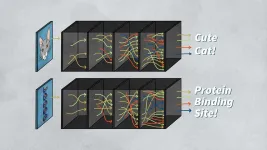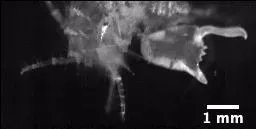Microbiota transfer therapy for autism: Multi-omic approaches and lessons learned
2021-02-08
(Press-News.org) During every instant of life, over a hundred trillion microbes, collectively known as the microbiome, reside on skin surfaces and course through the human body. In the human gut, vast colonies of bacteria, belonging to around 1000 different species, carry out duties ranging from the digestion of food and the management of body weight to effects on the brain and behavior, many of these still elusive to science.
Recent studies in mice and humans have revealed intriguing links between the composition of gut microbiota and Autism Spectrum Disorder (ASD), a disease believed to affect one in 54 children, according to the Centers for Disease Control. Dr. Krajmalnik-Brown's lecture will propose linkages between gut bacteria and ASD, highlighting encouraging results of a microbiome-targeted, ASD open-label clinical trial.
The approach described involves the transfer of healthy gut microbes into the gut of ASD patients over a period of 7-8 weeks, as a means of treating symptoms of the disorder. Known as microbial transfer therapy (MTT), the technique seeks to address the gastrointestinal issues commonly associated with ASD as well as offer relief from some of the characteristic behavioral manifestations of the disease.
ASD is a complex neurobiological disorder, whose roots are still unknown. The affliction often takes hold in early childhood, impairing social interactions and communication, leading to restricted, repetitive, and stereotyped patterns of behavior. Gut microbiota are known to play a role in ASD, which produces problems in the GI tract that are often correlated with ASD severity. Researchers have found an abnormal composition of gut bacteria in ASD patients who lack the broad microbial diversity associated with a healthy gut microbiome.
Krajmalnik-Brown, director of the Biodesign Center for Health Through Microbiomes at ASU, along with her colleagues, have extended earlier studies, administering MTT to 18 ASD-diagnosed children and carefully monitoring their GI and behavioral responses. The treatment began with a 2-week antibiotic regimen and bowel cleanse, a stomach acid suppressant, followed by an extended transplant of gut microbes from healthy individuals, using a high initial dose followed by daily and lower maintenance doses over a period of two months.
Initial results showed marked expansion in the diversity of gut microbia, an 80% reduction in GI symptoms and improvement in autism-related behavior. A review of the original 18 participants two years after MTT treatment showed further encouraging results. Most of the GI improvement following treatment was maintained while behavioral correlates of ASD further improved over time. Bacterial composition was significantly enhanced by the treatment, seen in particular in the in bacterial diversity and relative abundances of two species, Bifidobacteria and Prevotella, along with other taxa.
Following MTT, levels of many metabolites in plasma were shown to more closely resemble those in normally developing children, presumably as a result of adjusting ASD microbial colonies to more closely approximate the normal, healthy gut.
The research has benefitted from a multi-omic approach, which examines microbes, pathways, genes, and metabolites--potential candidates for more accurate biomarkers and targets for future treatment. "Through blood metabolomics we were able to see that the microbiome changes lead to systemic changes for meaningful metabolites. This is exciting and promising," Krajmalnik-Brown said.
The study findings suggest the long-term safety of the MTT method and provide a hopeful avenue of further research in the diagnosis and management of this widespread illness, for which there is still no established medical treatment.
INFORMATION:
ELSE PRESS RELEASES FROM THIS DATE:
2021-02-08
BUFFALO, N.Y. -- Passive cooling, like the shade a tree provides, has been around forever.
Recently, researchers have been exploring how to turbo charge a passive cooling technique -- known as radiative or sky cooling -- with sun-blocking, nanomaterials that emit heat away from building rooftops. While progress has been made, this eco-friendly technology isn't commonplace because researchers have struggled to maximize the materials' cooling capabilities.
New research led by University at Buffalo engineers makes significant progress in this area.
A study published Feb. 8 in the journal Cell Reports Physical Science describes a uniquely designed radiative cooling system that:
Lowered the temperature inside ...
2021-02-08
Ebola and Marburg are among the most deadly viruses, with mortality rates from these infections ranging from 25% to 90%. While no drugs currently are available on the market to prevent infection from these viruses -- they belong to a category of viruses called filoviruses, which are known to cause hemorrhagic fever -- researchers have identified a few small drug molecules that can block filoviruses from infecting cells by occupying a single site on a glycoprotein in the virus.
Now, researchers at the END ...
2021-02-08
Cold Spring Harbor Laboratory (CSHL) Assistant Professor Peter Koo and collaborator Matt Ploenzke reported a way to train machines to predict the function of DNA sequences. They used "neural nets", a type of artificial intelligence (AI) typically used to classify images. Teaching the neural net to predict the function of short stretches of DNA allowed it to work up to deciphering larger patterns. The researchers hope to analyze more complex DNA sequences that regulate gene activity critical to development and disease.
Machine-learning researchers can train a brain-like "neural net" computer to recognize objects, ...
2021-02-08
COLUMBUS, Ohio - We know that what happens in the mouth doesn't stay in the mouth - but the oral cavity's connection to the rest of the body goes way beyond chewing, swallowing and digestion.
The healthy human oral microbiome consists of not just clean teeth and firm gums, but also energy-efficient bacteria living in an environment rich in blood vessels that enables the organisms' constant communication with immune-system cells and proteins.
A growing body of evidence has shown that this system that seems so separate from the rest of our bodies is actually highly influential on, and influenced by, our overall health, said Purnima Kumar, professor of periodontology at The Ohio State University, speaking at a science conference this week.
For example, type 2 diabetes has long ...
2021-02-08
New research finds caffeine consumed during pregnancy can change important brain pathways that could lead to behavioral problems later in life. Researchers in the Del Monte Institute for Neuroscience at the University of Rochester Medical Center (URMC) analyzed thousands of brain scans of nine and ten-year-olds, and revealed changes in the brain structure in children who were exposed to caffeine in utero.
"These are sort of small effects and it's not causing horrendous psychiatric conditions, but it is causing minimal but noticeable behavioral issues that should make us consider long term effects ...
2021-02-08
One of humanity's biggest challenges right now is reducing our emissions of greenhouse gases into the atmosphere. Research groups worldwide are trying to find ways to efficiently separate carbon dioxide (CO2) from the mixture of gases emitted from industrial plants and power stations. Among the many strategies for accomplishing this, membrane separation is an attractive, inexpensive option; it involves using polymer membranes that selectively filter CO2 from a mix of gases.
Recent studies have focused on adding low amounts of metal-organic frameworks (MOFs) into polymer matrices to enhance their properties. MOFs are compounds made of a metallic center bonded to organic molecules in a very orderly fashion, producing porous crystals. When added to polymer ...
2021-02-08
DURHAM, N.C. -- The world's most technologically advanced robots would lose in a competition with a tiny crustacean.
Just the size of a sunflower seed, the amphipod Dulichiella cf. appendiculata has been found by Duke researchers to snap its giant claw shut 10,000 times faster than the blink of a human eye.
The claw, which only occurs on one side in males, is impressive, reaching 30% of an adult's body mass. Its ultrafast closing makes an audible snap, creating water jets and sometimes producing small bubbles due to rapid changes in water pressure, a phenomenon known ...
2021-02-08
Bark beetle outbreaks and wildfire alone are not a death sentence for Colorado's beloved forests--but when combined, their toll may become more permanent, shows new research from the University of Colorado Boulder.
It finds that when wildfire follows a severe spruce beetle outbreak in the Rocky Mountains, Engelmann spruce trees are unable to recover and grow back, while aspen tree roots survive underground. The study, published last month in Ecosphere, is one of the first to document the effects of bark beetle kill on high elevation forests' recovery from wildfire.
"The fact that Aspen is regenerating prolifically after wildfire is not a surprise," said Robert Andrus, who conducted ...
2021-02-08
A team of engineers and scientists has developed a method of 'multiplying' organoids: miniature collections of cells that mimic the behaviour of various organs and are promising tools for the study of human biology and disease.
The researchers, from the University of Cambridge, used their method to culture and grow a 'mini-airway', the first time that a tube-shaped organoid has been developed without the need for any external support.
Using a mould made of a specialised polymer, the researchers were able to guide the size and shape of the mini-airway, grown from adult mouse stem cells, and then remove it from the mould when it reached ...
2021-02-08
DANVILLE, Pa. - Researchers at Geisinger have found that a computer algorithm developed using echocardiogram videos of the heart can predict mortality within a year.
The algorithm--an example of what is known as machine learning, or artificial intelligence (AI)--outperformed other clinically used predictors, including pooled cohort equations and the Seattle Heart Failure score. The results of the study were published in Nature Biomedical Engineering.
"We were excited to find that machine learning can leverage unstructured datasets such as medical images and videos to improve on a wide range of clinical prediction models," said Chris Haggerty, Ph.D., co-senior author and assistant ...
LAST 30 PRESS RELEASES:
[Press-News.org] Microbiota transfer therapy for autism: Multi-omic approaches and lessons learned






